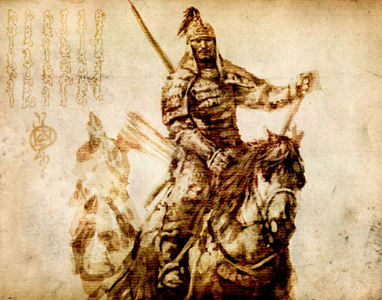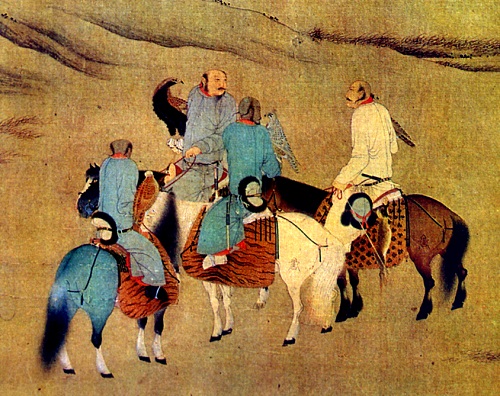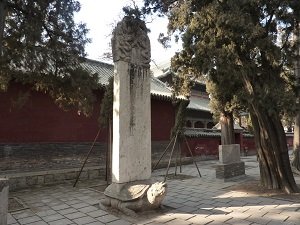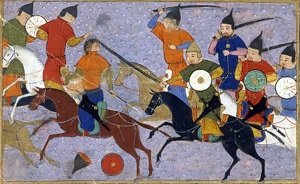Part V – The Mongol Empire: Yuan Dynasty 1279 – 1368
- Introduction
- Before the Yuan – Conquest of Northern China by the Tribal Dynasties of the Liao and Jin 907-1234
- Yuan Dynasty 1279-1368 – International Dynastic Court, Silk Road, Western Contact and Marco Polo
- Ghengis Khan
- Kublai Khan
- Chinese Traditions to rule Chinese People
- Trade and the Silk Road
- Westerners Come to China – Marco Polo
- The Art of the Yuan Dynasty
- Kublai Khan’s Death
- Dynastic Themes Present in China Today
- What Happened Next?
Introduction
The Yuan marked the only time that China was entirely conquered by the Mongols. Increasingly, by the end of the Song Dynasty, when the Chinese refused to trade on what the Mongols felt were acceptable terms, the herders resorted to raids to get what they wanted. Eventually, what the Mongols wanted was all of China. The Mongols used Chinese traditions to consolidate their rule over the Chinese people. Yet the Mongols also kept many Mongol customs and were influenced by the traditions of the distant parts of its wide-reaching Empire which, at its zenith, controlled not only China but also large parts of the Middle East, Russia, and Eastern Europe. This international reach contributed to making the Yuan one of China’s most international courts. The Mongols brought China renewed access to the Silk Road. Chinese exports of tea, silk and porcelain soared. These items were to remain China’s preeminent foreign currency generators throughout the Yuan dynasty. Chinese technologies such as paper printing, gunpowder and the compass spread to the distant reaches of the world over the Silk Road trade routes, influencing development trajectories in places as far-away as Europe.Before the Yuan – Conquest of Northern China by the Tribal Dynasties of the Liao and Jin 907-1234
Over the course of four centuries, parts of China were increasingly conquered by nomads who each formed their own dynasties – the Khitan’s Liao Dynasty, (907-1125), the Jurchen’s Jin Dynasty (1125-1234), climaxing with the Mongol’s Yuan Dynasty (1234-1368) which eventually encompassed all of China when the Southern Song finally capitulated to the Mongol conquest in 1276.
Despite the strong tribal affiliations of the various peoples of the steppe, the social organization of these nomads was remarkably similar. Patrilineal, the nomad families lived in clans which would merge into tribes with tribal chiefs selected for their military skill. All men were trained as potential warriors, learning to ride and shoot at a young age. Clans and tribes regularly preyed on each other, seizing cattle, horses, and women. Captives became slaves or servants. The alternative to fighting was to form alliances. At times, a strong tribal leader would build large coalitions. However, while the building of these alliances may have been initiated by one or a few chiefs, they were not, nevertheless, autocratic; major decisions were collectively reached at assemblies of military leaders. Loyalty and duty held the alliances together, as did the spoils of war campaigns. Yet such campaigns could not be indefinitely sustained and, within a generation or two, alliances often broke down and allied tribes would again return to combat.During the time leading to the formation of the Yuan Dynasty, the changing border zone between the steppe and China-proper was a large, fluid frontier settled by both nomads and ethnic Chinese where differences of ethnicity and ways of life between the two were not always clear-cut. Frontier non-Chinese might remain as herdsman, or they might become farmers or soldiers in Chinese military units, while the ethnic Chinese continued farming, engaged in forced government service, or served in the military, much as they had in the past. Some non-Chinese viewed themselves as part of their ethnic tribe, while others acknowledged the Chinese government and assimilated into the Chinese population.
The nomads’ ultimate success in conquering and ruling China derived in part from the skills and experience they acquired co-habituating with the Han Chinese in these frontier areas. The Khitan, for example, adopted hereditary succession on the Chinese model so that son would succeed father. They also adopted many governing institutions from Chinese practices. Ultimately, the reigning elite of the Khitan became culturally ambidextrous, adroit in both Khitan and Chinese ways. Nevertheless, they remained distinct from the Chinese population, predominantly preserving their tribal customs.
The Khitans were eventually brought down by the Jurchens, a tribal people originating in the mountains of eastern Manchuria whose descendants would later found the Qing Dynasty. The Jurchens’ military success derived in part from their use of Chinese experts in military siege warfare. Like the Khitans before them, the Jurchens found that Chinese political institutions were effective not only at ruling the Chinese majority, but also at controlling their own nobles. Unlike the Khitans, the Jurchens were quick to adopt Chinese language, dress, and rituals. Nevertheless, by the 1100s, there was a growing backlash from some Jurchen elite against the Jurchen’s increasing adoption of Chinese ways. In 1161, for instance, Jurchen military commanders executed the Jin emperor and then implemented efforts to revitalize the Jurchen heritage, including the use of Jurchen as a written language, the translation of Confucian classics into Jurchen, civil service examinations testing mastery of Jurchen and punishment of those Jurchens practicing Chinese customs. Despite these efforts, sinification of the Jurchens continued. By the end of the Jin dynasty, most Jurchens spoke Chinese, wore Chinese clothes, had adopted Chinese-style surnames and had married with the local population.
Yuan Dynasty 1279-1368 – International Dynastic Court, Silk Road, Western Contact and Marco Polo
While the Jin Dynasty had successfully managed to conquer and rule Northern China, they never fully managed to pacify the Mongolian steppe. This was to prove their downfall. When a drop in the mean annual temperature reduced the supply of steppe grass for grazing animals, the Mongol leader Genghis Khan solved his people’s subsistence crisis by attacking the Jurchens.
Ghengis Khan
Ghengis’ career as the Great Khan, or Mongolian overlord, began in 1206 when he was selected by a Mongolian assembly of military leaders. Genghis proceeded to organize Mongolian society into one of the most effective military machines the world has ever known. He built his army on diverse units of 1,000 horsemen whose members included varied tribal affiliations. He also created an elite bodyguard of 10,000 sons and brothers of commanders, which served directly under him. To minimize internal strife under his command, he created simple but draconian laws; robbery, for instance, was punished by death. Despite being illiterate, in order to communicate his orders more effectively, he also started to employ the Uyghur script to write the Mongol language.
Capable of enduring extreme privation, and travelling at astonishing speeds, his Mongols were superb warriors. Most of his soldiers travelled with several ponies and all were expected to shoot accurately at full gallop. Using terror effectively, Ghengis’ troops looted resisting cities. Genghis Khan was said to have declared that there is no greater joy than slaughtering one’s enemies, taking their horses and cattle and raping their women. Cities that did not resist were left untouched. Those that resisted were devastated. When the Mongol armies first swept across the North China plain in 1212-1213, for instance, Ghengis’ armies left 90 cities in rubble. When Ghengis captured Zhongdu (roughly present day Beijing) in 1215, it was said to have burned for more than a month.
Kublai Khan
By 1226, Ghengis was close to defeating the Jin in Northern China when he unexpectedly died. As a result, the Mongols halted their advancement to select a new Khan, as all Khans needed to be decided by assembly. In 1234, the Mongols finally defeated the Jin and took control of northern China. By 1253, the Mongols began to advance on the south. This military assault was led by Genghis Khan’s grandson, Kublai, among others. The Song raised large armies to fight the Mongols and employed the best available military technology, including simple handguns, rockets and flamethrowers. Both sides had sophisticated military catapults which hurled incendiaries and other loads. Nevertheless, the Song’s lack of horses proved a major disadvantage. Without a large cavalry force to face its enormously mobile enemies, Song defenders were largely restricted to positional warfare, fighting behind enormous fortressed walls. These were easily isolated. For a time, such fortresses blocked Mongol access to parts of the Song-held interior. Yet, by 1279, Kublai Khan had conquered all of southern China. In total, the Mongols numbered no more than 1.5 million. Their ultimate success derived in part by their willingness to incorporate other ethnic groups into their armies and government. In their efforts to conquer the Jurchens, for instance, the Mongols recruited both the Khitan and Chinese. Regardless of their ethnic group, those who served the Mongols faithfully were repaid with both wealth and position.
Having conquered China, Kublai Khan proclaimed himself the Emperor of the Yuan Dynasty and the rightful recipient of the Mandate of Heaven. Kublai Khan formed a court that practiced both Mongol and Chinese traditions. He employed Confucian ministers, created a Chinese style government, adopted a dynastic calendar and chose the name Yuan from The Book of Changes, the classical work esteemed by the Chinese. Nevertheless, Kublai and his court, like the Khitans before them, purposely avoided many Chinese social and political practices. The Mongol elite conducted their business in Mongolian and passed their summers in Mongolia. Mongols were discouraged from marrying Chinese, and Kublai himself took only Mongol women into the palace. Some Mongol princes erected their tents in the palace grounds as opposed to sleeping in palace accommodation. Mongols also continued to choose the rulers by competition, which was often bloody.
Kublai encouraged the creation of an international Chinese court culture where officials spoke Mongolian, Persian and Turkic dialects as well as Chinese. He also encouraged the creation of a highly international official cuisine, which reflected influences from the regions throughout the extended Mongolian empire. In terms of religion, Kublai Khan preferred native religious practices focused on shamanism, rain–making, and fertility magic, but he also showed royal patronage and support to the Chinese Daoists and Buddhist missionaries from Tibet. In particular, Tibetan Buddhism grew rapidly during the Yuan Dynasty.
The ethnic hierarchy of the Yuan’s diverse society was particularly complex. The Mongols enjoyed the most advantage, followed by the allies of the Mongols from areas outside China such as the Uyghurs and Tibetans. Former subjects of the Jin such as the Jurchens, sinified Khitans, and the Jin Chinese had second position. At the bottom of the social hierarchy were the former subjects of the Song. Each of the ethnic groups experienced different methods of taxation, judicial process and appointments to office. The Chinese from the North, for instance, were taxed in ways that reflected Jin practices, whereas the Chinese in the south were taxed in accordance with Song precedents. Each ethnic group was also judged and sentenced according to its own legal traditions. The Chinese, for instance, were the only ethnic group to be tattooed if convicted of theft.
Other ethnic divisions reflected the Mongols efforts to maintain dominance over the Chinese majority. The Chinese were not allowed to own weapons or to gather in public. It was also illegal for them to trade in bamboo, as it was used to make bows and arrows. If a Mongol murdered a Chinese, he was usually freed by paying a fine. If a Chinese murdered a Mongol, however, he was subject to severe penalties, usually execution.
Chinese Traditions to rule Chinese People
Although it would not have been the first choice of the Chinese to be ruled by ‘barbarians’, Confucianism argued that being a Barbarian was not in itself a barrier to receiving the Mandate of Heaven. The Chinese belief in their own superiority emanated not so much from a sense of ethnic supremacy, but from one of cultural pre-eminence. If the barbarians adopted Chinese ways – Confucian values, ancestor worship, Chinese civil bureaucracy and Chinese clothes and customs – they could become superior just like the ethnic Han Chinese.
However, neither the Khitans nor the Mongols became fully sinified. The Mongols were able to finesse this to some extent because ancestor worship stated that one’s obligations to one’s forebears meant that it would be a violation a filial piety if a sinified barbarian’s ancestors were not accorded the greatest respect. Worshipping with respect often meant that the barbarians needed to preserve and to worship in a manner that was consistent with their ancestral traditions. The Confucian obligation of loyalty to one’s ruler also tended to foster obedience to the barbarian emperors.
Nevertheless, many Han Chinese scholar-elites engaged in a desperate struggle to save Chinese civilization from what they viewed as the corrupting forces of their barbarian rulers. The Mongols’ policies favoring other ethnic groups over the Chinese further aroused Chinese ethnic consciousness and hostility. Yet, while the concept of a Chinese ethnic identity was undoubtedly developed and explored during this time, these explorations were still far from the equivalent of modern nationalism. Loyalty to one’s ruler remained, to many, the higher virtue.
Trade and the Silk Road
The initial Mongol conquest of China devastated much of the Song economy. Warfare reduced the population and brought disease, including the bubonic plague. Rice production fell significantly, and continuous warfare drained the state’s resources. Yet, once the Mongols had finally consolidated control over China, international trade expanded, and the economy thrived. The Silk Road, which had been closed to the Southern Song dynasty when they lost northern China to the Jin, was re-opened, despite periodic interruptions due to civil war between the remaining northern nomadic peoples. Within China, tea, rice and other foodstuffs moved in significant quantities throughout the empire. International trade was dominated by demand for Chinese textiles, tea and porcelain. Trade in the South China Sea continued to thrive. This trade was dominated by Muslims living within China as well as the Han Chinese. Europeans began exchanging goods with China during this time, especially those traders emanating from the great Italian trading city of Genoa.Westerners Come to China – Marco Polo
Western contact with China brought more than just trade. Scientific and technological developments were swapped, as were innovations in medicine. Chinese inventions such as printing, gunpowder and the compass also spread abroad during this time. Chinese geographical knowledge expanded. Accordingly, the Mongols created some of the world’s finest and most accurate maps of the time. The Mongol map Guang Yu Tu, “Extended Map of the Earth”, included remarkable detail of East Asia, extensive information on Africa, including its correct shape, and maps of Europe, including many of its most important cities.Increasingly, Western clerics and important trading families began visiting China. Although the facts of Marco Polo’s visit to China are still hotly debated, there is evidence to suggest that Marco Polo spent 17 years in Kublai’s China from 1275-1292. Whatever the actual extent of Polo’s exposure to China, he later wrote about his (fictional or non-fictional) travels in a book which became very popular in the West. It also served as an important contribution to Western understanding of China for centuries to come.
The Art of the Yuan Dynasty
The art of the Yuan Dynasty blended Chinese and other traditions. Porcelain production thrived during this era, with cobalt blue, the official color of the imperial court, dominating porcelain design. This porcelain became widely sought after as far away as Europe. In fact, its trade represented the first international art craze. Another significant cultural development in Mongol times was secular literature. Vernacular drama thrived – being written in the vernacular made it accessible to the illiterate – and some 167 Yuan plays survive today. Vernacular fiction also became increasingly popular, made available to a wide range of people through cheap printed editions. Yuan opera – four or five act dramatic operas – were also developed. They used mime, song, dance, and acrobatics to tell stories of love, war and politics.
Kublai Khan’s Death
Kublai Khan ruled China for 23 years. The 30 years following his death in 1294 marked the high points of Mongol rule in China. During this time, the Mongol government continued to be effective, and the Mongols had few enemies. This situation changed as conflict between members of the Mongol ruling elite, and a series of unimpressive emperors limited the Mongols’ ability to effectively rule. Climate change also worked against the dynasty. Between 1295-97, 1324-30 and 1342-45 China’s climate deteriorated drastically. Professor Brook of the University of British Columbia identified these three periods as part of what he called the Nine Sloughs, where climatic factors combined over several years in a sustained way to have catastrophic effects on the population. Globally, temperatures fell precipitously from 1270 onward as the Medieval Warm Period ended and the Little Ice Age began to extend its icy grip. Additionally, within China itself, during a famine in 1286, approximately 25% of China’s grain was lost at sea during its transport from southern China to northern China. The sea route was being used as the Grand Canal had fallen into disrepair. Additionally, in 1295, there was significant flooding along the Yangtze River. In 1296, both the Yangtze and the Yellow Rivers broke through their levees causing disastrous flooding along their banks. In 1297, the Dynasty was plagued by locusts. In 1303, China suffered severe earthquakes centered around Shanxi, resulting in the death of hundreds of thousands and leaving many more homeless. These and other negative climatic events compromised the ability of the ruling Yuan Dynastic elite to maintain control and equilibrium throughout the Empire. They also caused people to consider whether they were an indication that the Yuan Dynasty had lost the Mandate of Heaven.
Southern China, always a bastion of Chinese conservatism and the protector of Chinese cultural values, began to engage in passive resistance against the Mongols. Many Han elite refused to serve within the Mongol government, depriving it of much-needed cadres. Stoking the fires of popular resistance was the ubiquitous corruption that is common in all waning dynasties. Mongol favoritism of Tibetan Buddhists over Confucians also aggravated ethnic tensions. By the 1340s, bandits began to seize Southern Chinese towns and to form alliances with local elite to raise private armies. Eventually, sporadic rebellions gained enough momentum to precipitate the end of Mongol rule over China.
Dynastic Themes Present in China Today
The centrality of Confucianism to the Song Dynasty helped to sustain its rule in China-proper but served to leave it vulnerable to attack from the north. The disregard for military training at the expense of book learning may have been considered virtuous by Chinese elites, but a focus on scholarship resulted in a weak nation. This left China vulnerable to military defeat from a significantly smaller, but ultimately stronger military power. Though in present day China it can be argued that this is no longer a concern – China’s current relative military position cannot be compared with that of the Song’s – a similar error of judgment did occur during the Qing Dynasty, when it was assumed that the British could not be superior to the great Middle Kingdom. This misjudgment led to a series of costly military defeats.
Yet, despite the failings of Confucianism as a ruling ideology from the point of view of military preparedness, the success of the Yuan in subjugating the Chinese lay in the acknowledgement of Confucianism’s cultural value. This return to Confucianism as a cultural norm would also be echoed in the Qing Dynasty when another foreign race, the Manchus, conquered China and proceeded to rule the Dynasty for over three centuries.
Despite the Yuan Dynasty originating from the conquering of the Chinese by a barbarian force, Kublai Khan is considered in China to have been Chinese. That he was Mongolian is no barrier to his recognition as a Chinese Emperor, as Mongolians are seen as one of China’s official 56 ethnic groups. Furthermore, the shape of the Yuan Dynasty is extremely close to territory of the modern day People’s Republic of China and this is often cited by Chinese scholars and government officials as historical evidence that Tibet is an inalienable part of China. Whether or not this is an acceptable argument depends to some extent on whether one accepts the Yuan Dynasty as a Chinese Dynasty or if, as some argue, it should be considered a foreign occupation of Chinese lands.
What Happened Next?
The demise of the Mongol empire in China was concluded when Zhu Yuanzhang, a peasant-born military leader, drove the remnants of the Yuan back into the Mongolian grasslands. An autocratic regime followed. During the Ming Dynasty the Chinese ventured across the seas and discovered far off lands but elected not to engage in the kind of colonization favored by the European powers. Instead, eventually the Ming Dynasty turned in on itself, ushering in a period of isolation from international influence. The story continues in Exploration, Consolidation, Isolation.


![By Riddleone (Own work) [CC-BY-SA-3.0-2.5-2.0-1.0 (http://creativecommons.org/licenses/by-sa/3.0) or GFDL (http://www.gnu.org/copyleft/fdl.html)], via Wikimedia Commons](https://chinafolio.com/wp-content/uploads/2010/05/Map-of-Mongol_empire-wiki1.jpg)
![By Rashid al-Din [Public domain], via Wikimedia Commons](https://chinafolio.com/wp-content/uploads/2010/05/Mongol_soldiers_-wiki.jpg)





![By Immanuel Giel (Own work) [CC-BY-SA-3.0 (http://creativecommons.org/licenses/by-sa/3.0)], via Wikimedia Commons](https://chinafolio.com/wp-content/uploads/2010/05/Dunhuang-Gansu-Province-once-a-major-stop-on-the-Silk-Road-wiki.jpg)
![By Captmjc (Own work) [GFDL (http://www.gnu.org/copyleft/fdl.html) or CC-BY-SA-3.0 (http://creativecommons.org/licenses/by-sa/3.0/)], via Wikimedia Commons](https://chinafolio.com/wp-content/uploads/2010/05/Marco-Polo-statue-in-Hangzhou-China-wiki.jpg)




